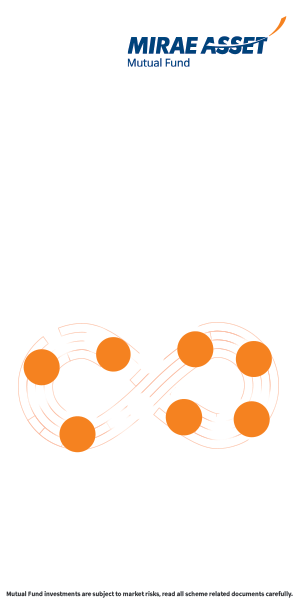Why ELSS Tax Saving Mutual Funds is best choice for tax planning

Investors can save up to Rs 46,350 in taxes per year by investing up to Rs 1.5 Lakhs in eligible schemes under Section 80C of the Income Tax Act 1961. There are broadly two types of tax savings schemes – risk free or low risk schemes and market linked schemes. The risk free or low risk schemes are Public Provident Fund (PPF), National Savings Certificates (NSC), 5 year tax saving Fixed Deposits (offered by banks and post office), traditional life insurance plans (e.g. endowment plans, money back plans etc), Senior Citizens Savings Schemes etc. In these schemes capital safety is assured. In some schemes like NSC, FDs returns (interest) are guaranteed, while in others the interest rates can change from time to time over the investment tenure.
The market linked schemes under Section 80C are ELSS Tax Savings Mutual Fund Schemes or Equity Linked Savings Schemes (ELSS) and Unit Linked Insurance Plans offered by life insurance companies. ELSS and ULIPs invest in capital market securities and therefore, they are subject to market risks. If you want assurance of capital safety then market linked schemes are not for you and you should invest in Government small savings schemes (PPF, NSC etc) or Bank tax saving FDs.
However, if you are willing to take risks and are prepared to remain invested even beyond the lock-in period of these schemes then ELSS is the best tax saving investment choice. ELSS enjoys three big advantages compared to other tax saving investments.
- Potential of giving superior returns
- Favourable tax treatment
- Superior liquidity
In this blog post we will discuss these advantages of ELSS vis a vis other 80C schemes.
Superior Returns
Historical data shows that, equity is best performing asset class in the long term. In the last 20 years, the S&P BSE – Sensex gave 11.7% compounded annual returns, while bank FDs gave average annualized returns of only 7% over the entire period. Many investors focus simply on tax savings and ignore the growth potential or the tax implications on the maturity amount. The result is that, they get sub-optimal returns which struggle to beat inflation on a post tax basis. ELSS tax saving mutual fund Schemes, on the other hand, offer both 80C tax savings and wealth creation potential over a sufficiently long investment horizon. The table below shows the post tax inflation adjusted rate of different 80C investment schemes over the last 5 years.
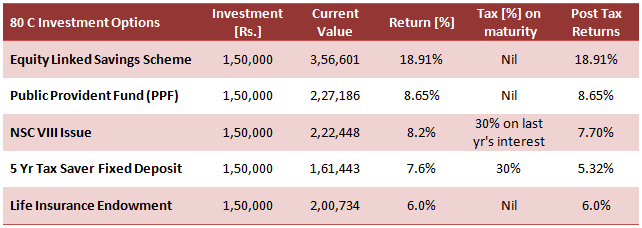
Key Assumptions:
The investor is the in highest (30%) tax bracket. Average category returns over the last 5 years have been assumed for ELSS. Please note top performing ELSS schemes gave higher returns. Life insurance endowment plans returns assumption is based on prevailing IRRs of life insurance endowment plans.You can see in the table above that, ELSS has outperformed all other 80C schemes. Notice the last column post tax returns. You can see how some returns can seem attractive on a pre-tax basis, but low on a post tax basis. We will discuss the taxation aspect in more details later in this post. Let us now discuss another important aspect that is often ignored by investors, when looking at returns and when making investment decisions.
You will see many people complaining about rising prices, but how many people factor in inflation when making investment decisions? In the chart above, we saw post tax returns of several Section 80C investment schemes over the last 5 years. Let us now bring inflation into the picture. The chart below shows the CPI inflation rate from 2013 to 2017.
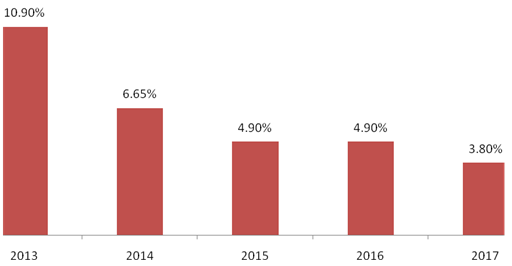
Source: World Bank
You can see that, in some years risk free returns (interest rates) struggle to beat inflation. From 2013 to 2017 the average inflation rate was 6.2%. Now look at the post tax returns of 80C investment options over the last 5 years and compare it with inflation. You will see that, risk free returns for some 80C schemes were lower than inflation.
I would urge all investors among Advisorkhoj readers to think about risk free investments in relation to inflation. Risk Free investments might be free from market risks, but they are not entirely risk free in the sense that, they are not free from inflation risk. If post tax risk free returns are lower than inflation, then by investing in risk free investments you are destroying wealth instead of creating wealth. Equity Linked Savings Schemes on the other hand, beat inflation by a wide margin and created wealth for investors (as you can see in the table above).
ELSS versus ULIP
Some readers may want to know, how ELSS fared against ULIPs, another market linked 80C investment scheme. Average large cap oriented ULIPs gave around 15% annualized returns (source: Morningstar) in the last 5 years. These returns are similar (slightly lower) than ELSS returns. However, a number of charges are deducted from your ULIP premiums before they are invested. Premium allocation charges are usually deducted from your first year premium to pay for the expenses incurred by the insurer (like underwriting fees, medical expenses, agent’s commission etc) for issuing your ULIP policy. Premium allocation charge can be as high as 20% of your premium. Every month policy administration charges are deducted by canceling units allotted to you.
Fund management charges (capped at 1.5% by the insurance regulator, IRDA) are also deducted. Some financial planners argue that, the fund management charges of ULIPs are lower than the expense ratios of ELSS tax saving mutual funds. However, the other expenses are higher and it usually takes a very long time for the lower fund management charges to offset the effect of other charges. In recent years, quite a few low cost online ULIPs have been launched, where premium allocation charges have been reduced (even to zero for some ULIPs). However, even for low cost ULIPs, you have to pay mortality charges. Mortality charge is the cost of your life insurance cover. Mortality charges are calculated based on the age and the health risk of the investor.
Some financial planners and insurance advisors say that mortality charges are beneficial for the investor because it provides financial protection to the investor’s dependants in the event of an untimely death. This is where comparison of a pure investment product like ELSS and investment cum insurance product like ULIP becomes problematic. Before investing in ULIP for 80C tax savings benefits, investors should ask themselves, what is the purpose of the tax savings investments? Is it tax savings and capital appreciation or does the investors have other benefits in mind, like life insurance. If your investment objective is purely tax savings and capital appreciation, then ELSS tax saving mutual funds is the superior investment choice because the total cost is lower and returns are likely to be much higher than ULIPs.
In Advisorkhoj, our view is that, you should separate your insurance and investment needs. For your investment needs you should invest in mutual funds and for your insurance needs you should buy pure term life insurance policies.
Tax Treatment
To fully evaluate the impact of taxes on any investment, one must understand the tax treatment at three different stages of investment:-
- At the time of making the investment
- During the tenure of the investment
- On maturity of the instrument
The table below shows the tax treatment at each stage for various 80C investment options
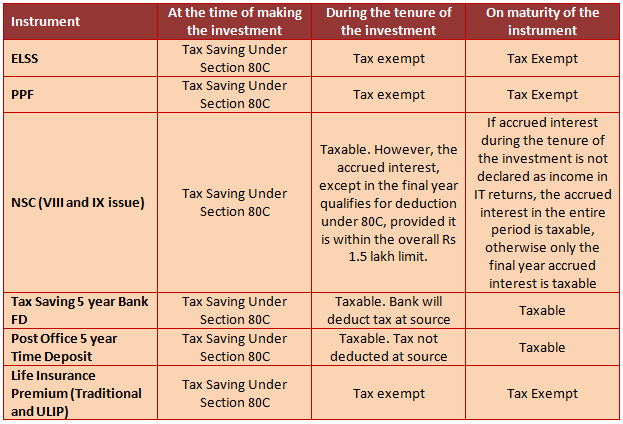
You can see that ELSS, PPF and life insurance plans are the most tax friendly investment options under Section 80C. However, as discussed earlier then ELSS tax saving mutual funds scores above PPF and life insurance plans in terms of returns.
Liquidity
The other important investment consideration is liquidity. There is no general financial planning guidance on liquidity. It depends on the financial situation of the investor like, income, fixed expenditure, savings pattern, existing assets, liquidity of those assets etc. When you make an investment, you should make sure that you are comfortable with the liquidity of the investment that you are making. The table below shows the liquidity related considerations for these investment options.
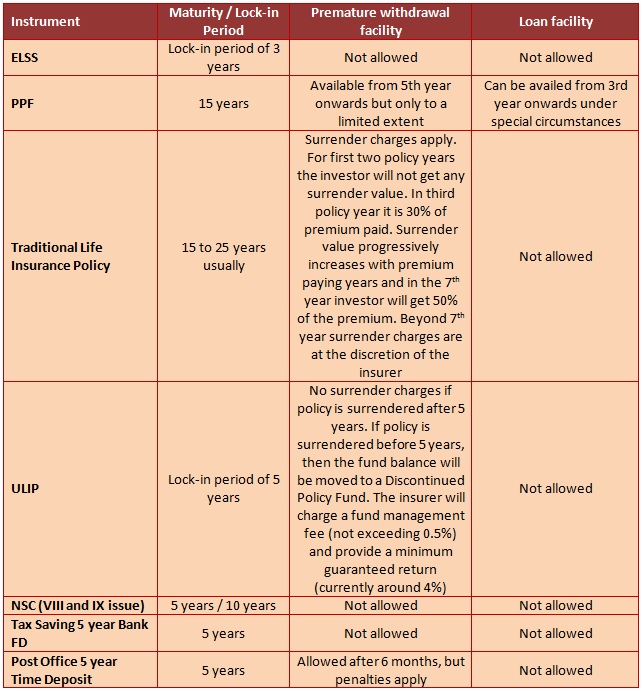
You can see that even in terms of liquidity then ELSS tax saving mutual funds is superior of all other 80C investment schemes. It has the shortest lock-in period. After 3 years, you can withdraw your money as per your own requirements or remain invested if you want to higher capital appreciation.
Conclusion
In this post, we discussed about ELSS tax savings mutual funds or ELSS Funds (Equity Linked Savings Schemes)as they are popularly known and their different characteristics. ELSS tax savings mutual fund schemes offer superior wealth creation potential, liquidity and tax benefits compared to other 80C investment choices. You should discuss with your financial advisor if ELSS tax savings mutual funds or ELSS funds are suitable for your tax planning investments.
Mutual Fund Investments are subject to market risk, read all scheme related documents carefully.
RECOMMENDED READS
Mirae Asset Global Investments is the leading independent asset management firm in Asia. With our unique culture of entrepreneurship, enthusiasm and innovation, we employ our expertise in emerging markets to provide exceptional investments opportunities for our clients.
Quick Links
- Fund Manager Interview - Mr. Neelesh Surana - Chief Investment Officer
- Fund Review - Mirae Asset Emerging Bluechip Fund : Best Midcap Mutual Fund in the last 6 years
- Fund Review - Mirae Asset India Opportunities Fund: One of the best SIP returns in last 8 years
- Fund Manager Interview - Mr. Neelesh Surana - Chief Investment Officer
- Our Articles
- Our Website
- Investor Centre
- Mirae Asset Knowledge Academy
- Knowledge Centre
- Investor Awarness Programs
Follow Mirae Assets MF
More About Mirae Assets MF
POST A QUERY



